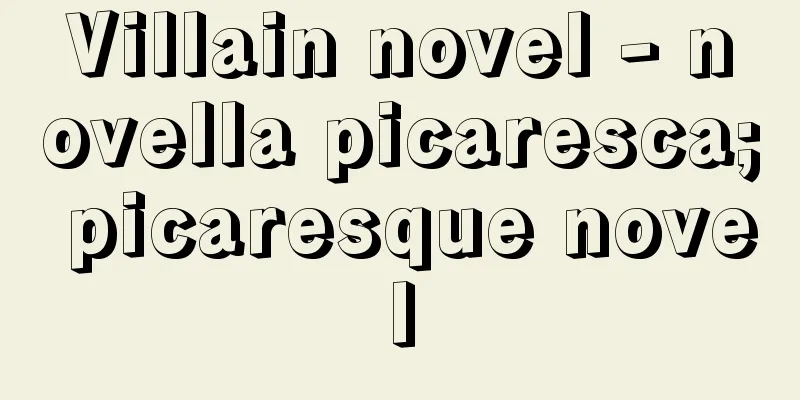Villain novel - novella picaresca; picaresque novel

|
Also called rogue novel or picaresque novel, it is a satirical depiction of society, telling the story of a roving rogue adventurer (picaro in Spanish) from the lower classes who lives a tough life while serving masters from various social classes. It is usually told in the first person. It has an episodic structure similar to medieval chivalric tales, but whereas the protagonists of chivalric tales are idealistic itinerant knights, the protagonists of rogue novels are cynical, without a moral code, and prefer to live by their own wits rather than honorable work when there is even the slightest chance. The picaro, who wanders from place to place, makes bold moves among people of all classes and professions, and narrowly escapes punishment for lying, cheating, and stealing, is an outsider free from the constraints of existing social norms and morals, although he does conform to them outwardly if it serves his own purposes. The picaro's stories ultimately portray social hypocrisy and corruption in a satirical way, while at the same time giving the reader a deep insight into the lives of people of low status and modest means. The first villain novel was the Spanish La Via de Lazarillo de Tormes (1554), which tells the story of a poor boy, Lazaro, who passes from one merchant to another, a priest, whose shady side hides behind a mask of hypocrisy. Its irreverent wit made it very popular at the time. The next villain novel was Guzmán de Alfarace (1590) by M. Alemán, which became the prototype of the genre and was one of the catalysts for the introduction of realism into the Spanish novel. Taking the form of an autobiography of the son of a bankrupt Genoese moneylender, this work is imaginative, has many anecdotes, and has better character development than La Via de Lazarillo de Tormes. It also enjoyed phenomenal popularity. Among the many short stories that followed Guzmán de Alfarace were the rogue-style short stories Rinconéte and Cortadillo (1613) and The Dialogue of the Dogs (13) by M. de Cervantes. FL de Úbeda's Justina the Villain (1605) is a story about a female picaro who deceives her lover just as the picaro deceives his master. FG de Quevedo y Villegas's The Life of a Trickster (26) is a masterpiece of the genre, and shows a deep concern for moral values behind it, combined with an excellent technique for describing the psychology of the trickster. After this work, the Spanish rogue novel gradually declined, giving way to adventure novels. After the translation of Lazarillo de Tormes into French, Dutch, and English in the second half of the 16th century, the picaro entered the literature of other European countries. The first rogue novel in England was T. Nash's The Unfortunate Traveller (1594). In Germany, H.J.C. von Grimmelshausen's Simplicissimus (1669) was a representative work. In England, the female picaro was revived in D. Defoe's Moll Flanders (1722). Elements of the rogue novel can also be found in H. Fielding's Joseph Andrews (42), The Life of Jonathan Wilde the Robber (43), Tom Jones (49), T.G. Smollett's Roderick Random (48), and The Adventures of Peregrine Pickle (51). In France, A.R. Le Sage's The Story of Gilles Bras (1715-35) is set in Spain like the original villain novels and borrows anecdotes from forgotten Spanish novels, but the picaro depicted is more gentlemanly and humane. In the mid-18th century, the realist novel with its solid and complex plots gained prominence, and the villain novel was considered somewhat inferior in art and began to decline completely. However, the satire that comes from the inclusion of characters from all walks of life, the vivid portrayal of artisans and merchants, the verisimilitude of language and details, and the ironic and detached observation of attitudes and morals that characterize the villain novel contributed to the development of realism in the 18th and 19th centuries. Elements of the villain novel reappear in some mature realist novels. Examples include N. Gogol's Dead Souls (1842-52), M. Twain's The Adventures of Huckleberry Finn (84), and T. Mann's The Confessions of Felix Krull (1954). Source: Encyclopaedia Britannica Concise Encyclopedia About Encyclopaedia Britannica Concise Encyclopedia Information |
|
悪漢小説,ピカレスク小説ともいう。下層階級出身の悪漢的冒険者 (スペイン語でピカロ picaro) が,各地を放浪して,さまざまな社会階級の主人に仕えながらたくましく生きる物語で,社会を風刺的に描く。通常一人称で語られる。挿話的な構造をもつ点で中世の騎士道物語に似ているが,騎士道物語の主人公が理想主義的な遍歴の騎士であるのに対し,悪者小説の主人公ピカロは冷笑的で道徳規準をもたず,わずかでも見込みがあれば高潔な仕事よりも自分の才覚で生きていくことを選ぶ。各地を放浪して,ありとあらゆる階級と職業の人々の間で大胆な行動をとり,すんでのところで嘘,詐欺,盗みに対するとがめを逃れるピカロは,階級にとらわれないアウトサイダーで,現存する社会規範や道徳観に内面を縛られることはないが,自分の目的にかなえば外面はいちおう調子を合せる。ピカロの物語は,結果的に社会の偽善と腐敗を皮肉に描き出し,同時に身分の低い,つつましい暮しの人々についての深い洞察を読者に与える。 最初の悪者小説はスペインの『ラサリーリョ・デ・トルメスの生涯』 (1554) で,貧しいラサロ少年が,偽善の仮面の陰にいかがわしさを隠している7人の商人と聖職者のもとを転々とする物語である。この作品は不遜な機知が受けて,当時非常に幅広く読まれた。次に出版された悪者小説はこのジャンルの原型となった M.アレマンの『グスマン・デ・アルファラチェ』 (99) で,写実主義がスペイン小説の主流となるきっかけの一つになった。破産したジェノバの金貸しの息子の自伝という形式をとるこの作品は,創造性に富み,エピソードも多彩で,『ラサリーリョ・デ・トルメスの生涯』よりも人物がよく描かれている。この作品も驚異的な人気を集めた。『グスマン・デ・アルファラチェ』に続いて現れた多くの短編小説のなかには,M.デ・セルバンテスによる悪者小説風の短編小説『リンコネーテとコルタディーリョ』 (1613) と『犬たちの対話』 (13) がある。 F.L.デ・ウベダの『悪女フスティーナ』 (1605) は,ピカロが主人をだますように,女ピカロが恋人をだます話である。 F.G.デ・ケベド・イ・ビリエガスの『ぺてん師の生涯』 (26) はこのジャンルの代表作で,ぺてん師の心理描写の卓抜な手法と相まって,その背後には道徳的価値に対する深い関心がうかがわれる。この作品ののち,スペインの悪者小説は次第に衰退し,冒険小説にその座を譲った。 16世紀後半に『ラサリーリョ・デ・トルメスの生涯』がフランス語,オランダ語,英語に翻訳されると,ピカロはほかのヨーロッパ諸国の文学に進出した。イギリスにおける最初の悪者小説は T.ナッシュの『不運な旅人』 (1594) である。ドイツでは H.J.C.フォン・グリンメルスハウゼンの『ジンプリチシムス (阿呆物語) 』 (1669) が代表作である。イギリスでは D.デフォーの『モル・フランダーズ』 (1722) で女ピカロが復活した。 H.フィールディングの『ジョーゼフ・アンドルーズ』 (42) ,『大盗ジョナサン・ワイルド伝』 (43) ,『トム・ジョーンズ』 (49) ,T.G.スモレットの『ロデリック・ランダム』 (48) ,『ペリグリン・ピクルの冒険』 (51) にも悪者小説の要素がみられる。フランスでは,A.R.ル・サージュの『ジル・ブラス物語』 (1715~35) がある。この作品は当初の悪者小説のようにスペインを舞台に,忘れられてしまったスペインの小説から挿話を借用しているが,描かれているピカロはより紳士的で人間的である。 18世紀中頃になると,堅牢で複雑なプロットをもつ写実主義小説が台頭し,悪者小説はいくぶん芸術的に劣るとされて,完全な衰退に向った。けれども悪者小説の特徴である,あらゆる階層の人物が登場するところから生れる風刺,職人や商人のいきいきとした描写,真実味あふれる言葉と細部,態度や道徳に関する皮肉で超然とした観察は,18~19世紀における写実主義小説の発展に寄与した。円熟した写実主義小説のなかにも悪者小説の要素が再び現れているものがある。その例としては,N.ゴーゴリの『死せる魂』 (1842~52) ,M.トウェーンの『ハックルベリー・フィンの冒険』 (84) ,T.マンの『詐欺師フェーリックス・クルルの告白』 (1954) があげられる。 出典 ブリタニカ国際大百科事典 小項目事典ブリタニカ国際大百科事典 小項目事典について 情報 |
<<: Walras - Marie Esprit Léon Walras
Recommend
Shinonoi Line - Shinonoi Line
The name of the East Japan Railway Company's ...
Bambusicola thoracica (English name: Bambusicola thoracica)
A bird of the genus Phasianidae (illustration). To...
Basileios (of Cappadocia) (English spelling)
330-379 A Greek Church Father who worked hard to r...
Lakhm Dynasty - Lakhm
An Arab kingdom of the Tanufs in southern Mesopota...
Grasping Bridge - Akukyo
...Suspension bridges suspended by iron chains in...
SNAP Plan
…RI has a smaller output than nuclear reactors, b...
Kikkuli
The Mitanni Kingdom was at its height of power du...
Scale insects - Scale insects
A general term for insects in the Hemiptera family...
Irobe clan annual events - Irobe clan annual events
This is a record of the household taxes and proper...
Jehu
…But Ahab's queen, the Phoenician Jezebel, fo...
Control tower - Kanseito (English spelling) control tower
A tower-like structure established primarily for ...
Yan-jing; Yen-ching
The ancient name of Beijing, the capital of China....
Pot stone - Tsuboishi
A pot-shaped nodule solidified with lime and iron....
Academic Society - Gakkai
An academic society is an organization, group, or...
Weather illness - weather sickness
This refers to a series of diseases whose symptom...





![Higashiawakura [village] - Higashiawakura](/upload/images/67cc99674d380.webp)



